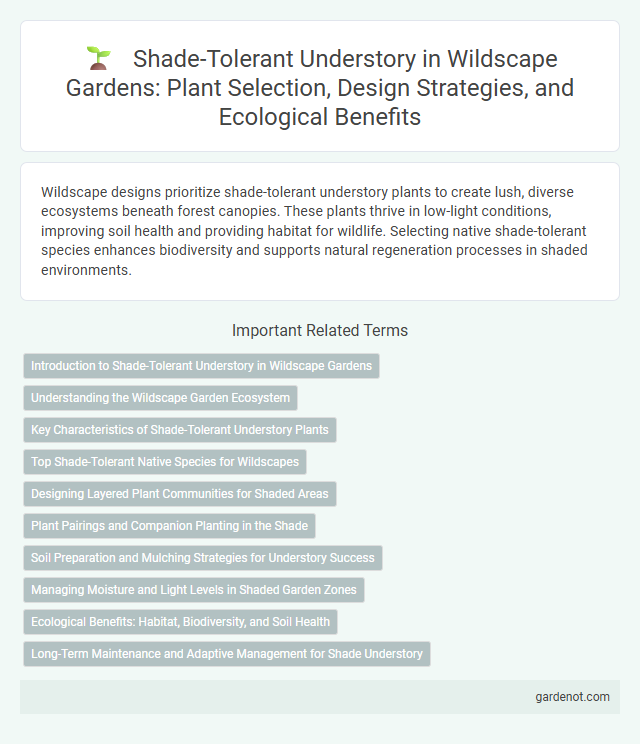Wildscape designs prioritize shade-tolerant understory plants to create lush, diverse ecosystems beneath forest canopies. These plants thrive in low-light conditions, improving soil health and providing habitat for wildlife. Selecting native shade-tolerant species enhances biodiversity and supports natural regeneration processes in shaded environments.
Introduction to Shade-Tolerant Understory in Wildscape Gardens
Shade-tolerant understory plants in Wildscape Gardens thrive beneath dense canopies, adapting to low-light environments with specialized foliage and growth patterns. These plants contribute to biodiversity by providing essential habitat and food sources for various wildlife species while enhancing soil stability and nutrient cycling. Select species such as ferns, hostas, and native wildflowers create a layered ecosystem that supports ecological balance and aesthetic diversity in shaded garden areas.
Understanding the Wildscape Garden Ecosystem
Shade-tolerant understory plants play a crucial role in the Wildscape garden ecosystem by thriving under the canopy where sunlight is limited. These plants contribute to biodiversity by providing habitat and food sources for various pollinators and soil organisms, enhancing ecological balance. Their ability to adapt to low light conditions supports soil moisture retention and nutrient cycling, vital for sustaining the garden's health.
Key Characteristics of Shade-Tolerant Understory Plants
Shade-tolerant understory plants exhibit key characteristics such as broad, thin leaves with high chlorophyll content to maximize light absorption in low-light environments. These plants typically have slower growth rates and efficient photosynthesis mechanisms to thrive beneath dense forest canopies. Adaptations like flexible stems and deep root systems enable them to compete for limited light and soil nutrients within the shaded understory.
Top Shade-Tolerant Native Species for Wildscapes
Top shade-tolerant native species for wildscapes include Trillium, Jack-in-the-pulpit, and Solomon's seal, which thrive under dense tree canopies and support local biodiversity. These understory plants contribute to soil health, provide habitat for pollinators, and enhance the structural complexity of wildscapes. Incorporating native shade-loving flora ensures ecological balance and resilience in shaded woodland environments.
Designing Layered Plant Communities for Shaded Areas
Shade-tolerant understory plants such as ferns, hostas, and astilbes thrive in low-light conditions, making them ideal for creating layered plant communities in shaded wildscapes. Designing these communities involves selecting species with varied leaf textures, heights, and bloom times to maximize biodiversity and aesthetic appeal while ensuring competition for light and nutrients remains balanced. Incorporating native shade-adapted shrubs and groundcovers enhances soil stability and supports local wildlife, promoting a sustainable and resilient shaded ecosystem.
Plant Pairings and Companion Planting in the Shade
Shade-tolerant understory plants such as ferns, hostas, and astilbes thrive when paired with companions like heucheras and Solomon's seal, creating a layered, textured wildscape. Effective companion planting in shade enhances soil moisture retention and discourages weeds, promoting healthier growth and biodiversity. These plant combinations support a balanced ecosystem by attracting beneficial insects and providing habitat for shade-loving wildlife.
Soil Preparation and Mulching Strategies for Understory Success
Shade-tolerant understory plants thrive in well-drained, nutrient-rich soils augmented with organic matter to enhance moisture retention and aeration. Effective soil preparation involves loosening compacted soil, incorporating compost, and maintaining a slightly acidic to neutral pH range of 5.5-7.0 to optimize root development. Mulching with high-quality organic materials like shredded leaves or bark suppresses weeds, conserves soil moisture, and gradually enriches the soil, promoting healthy understory growth in wildscape environments.
Managing Moisture and Light Levels in Shaded Garden Zones
Maintaining optimal moisture and light levels in shaded garden zones is crucial for the health of shade-tolerant understory plants in Wildscape landscapes. Employing drip irrigation and mulching techniques helps retain consistent soil moisture while preventing waterlogging. Selecting native understory species that thrive in low-light conditions ensures better growth and biodiversity in these shaded environments.
Ecological Benefits: Habitat, Biodiversity, and Soil Health
Shade-tolerant understory plants in wildscapes create critical habitat for diverse wildlife, supporting a rich range of birds, insects, and small mammals. These plants enhance biodiversity by providing food sources and shelter, fostering ecosystem resilience in forested environments. Their deep root systems improve soil health through increased organic matter, nutrient cycling, and erosion control, contributing to long-term ecosystem stability.
Long-Term Maintenance and Adaptive Management for Shade Understory
Long-term maintenance of shade-tolerant understory in wildscapes requires regular monitoring of soil moisture, light levels, and native plant health to ensure sustainable growth. Adaptive management strategies prioritize the removal of invasive species, periodic thinning of canopy trees to optimize light penetration, and the reintroduction of native understory flora to restore ecological balance. Consistent data-driven adjustments help maintain biodiversity and resilience in shaded woodland ecosystems.
Shade-tolerant understory Infographic

 gardenot.com
gardenot.com